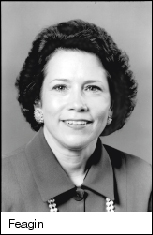The University Record, December 14, 1998
Faculty support critical in fund-raising
By Jane R. Elgass
 Susan Feagin joined the U-M seven months ago as vice president for development because of its success in leading public universities in private fund-raising and “its remarkable potential to raise a lot more money,” she told members of Senate Assembly at its Dec. 7 meeting.
Susan Feagin joined the U-M seven months ago as vice president for development because of its success in leading public universities in private fund-raising and “its remarkable potential to raise a lot more money,” she told members of Senate Assembly at its Dec. 7 meeting.
That potential, she added, assumes that the ingredients that have fueled past successes continue. These include:
• Outstanding leadership of the institution.
• Persuasive priorities and needs.
• Sufficient investment in Universitywide development operations.
• Alumni and friends who are committed to the University and willing to support the institution in both contributions and volunteer activities.
• Support of the faculty.
“Just raising money is not enough, however,” Feagin noted. “We do ourselves a disservice if we focus relentlessly on the bottom line and comparing ourselves to our peers.”
Feagin also noted that just having “a great development staff is not enough.” Successful fund-raising also must rely on “the active support of faculty” and on individuals who have made generous gifts serving as volunteer leaders in soliciting other gifts.
This does not necessarily mean faculty must become gift solicitors, but “you need to translate achievements and needs,” Feagin told Assembly members.
Feagin responded to a number of audience questions, including:
• Are there guidelines for naming opportunities, such as for professorships or buildings?
A minimum of $1.5 million is required to endow a professorship. Buildings are dealt with on a case-by-case basis, but generally 50 percent of the goal is required.
• How can faculty connect with donors?
There are a number of programs for donors, designed to help them find out about “the exciting intellectual life at the University,” Feagin explained. These include presentations by faculty to small groups and small dinners with a faculty member at each table, as well as one-on-one sessions when a donor has expressed a particular interest.
Faculty interested in meeting with potential donors should first contact their unit development officer, as well as Feagin’s office.
• What is the breakdown between large and small gifts?
In the Campaign for Michigan that ended last year, the U-M raised $1.4 billion. Of that, $1.1 billion was in gifts and pledges. The remaining was in bequest intentions. Of the $1.1 billion, 55 percent of the gifts were $1 million or more. The Campaign also showed “very great strength” in contributions of $25,000 to $1 million, Feagin added, probably owing to the U-M’s large number of alumni. “This is not a democratic process. You talk to people according to their financial ability.”
• Do private gifts affect the state appropriations?
Feagin said it is her understanding that the U-M has not been put in a situation in which the state has said, “If you raise a lot of money, we’ll reduce appropriations.”
“What is most important,” she said, “is that the state provides more than the equivalent of a $6 billion endowment. I look at the state as our biggest donor.”
• Will the Campaign for Michigan be extended, to reach $2 billion?
No. The campaign officially closed Sept. 30, 1997, which Feagin said was the right decision. “The goal was met, and new leadership was arriving. We can now step back and take a new look at priorities.”
The good news, she added, is that the campaign “didn’t exhaust everybody. The deans realized the power of private giving and haven’t really ratcheted down their level of effort. We hope to hold to the same dollars this year as we did for the campaign.”
President Lee C. Bollinger and Provost Nancy Cantor are looking at a new set of priorities, Feagin said, but there’s no timetable yet for a new campaign. “It’s not enough to just raise money. We want to raise it for the right things.”
• How are fund-raising goals identified?
This is done “strictly on the academic side of the house by the president, provost, deans and faculty,” Feagin said. “I weigh in with realistic expectations.”
• How are campus development activities structured?
The central development operation headed by Feagin has about 100 staff members, ranging from gift recorders to major gifts officers who are assigned to regions of the country and work in support of unit development officers. The unit also has a section for corporate and foundation gifts, and provides the infrastructure to units for phone solicitations and annual gift mailings.
Some of the large campus units, Feagin explained, may have significant development staffs, while the smaller ones may have only one or two people. She recently attended a meeting of individuals representing the “Jewels of the University” (the libraries, museums, Musical Society and similar organizations) and noted that there were 40 people there, “all of whom felt some fund-raising responsibility.”
Information about development programs and activities is available online at www.giving.umich.edu.
You can always drop us a line: [email protected].

